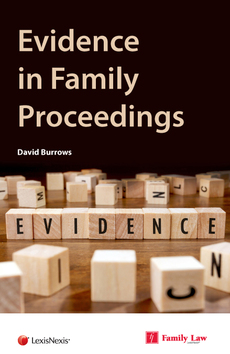Book review: Evidence in Family Proceedings by David Burrows
In a series of posts on this blog, author David Burrows has been examining the impact on family law and practice of reported cases arising in other areas of law. Now Iain Large reviews his recently published book, Evidence in Family Proceedings, and welcomes a valuable new entry into a busy marketplace. Evidence in Family Proceedings… Continue reading
In a series of posts on this blog, author David Burrows has been examining the impact on family law and practice of reported cases arising in other areas of law. Now Iain Large reviews his recently published book, Evidence in Family Proceedings, and welcomes a valuable new entry into a busy marketplace.
Evidence in Family Proceedings
By David Burrows (LexisNexis / Jordans Family Law Price: £70.00)
Is there something inherently contradictory about a book on evidence in family proceedings? In stark contrast to the smorgasbord of criminal and civil evidence manuals on offer in the pages of the legal publishers’ latest catalogues, there is little to nothing specific to family law. As to why this might be, Lord Sumption may have offered some explanation when he remarked, in Prest v Petrodel Resources Ltd [2013] UKSC 34; [2013] 2 AC 415 at [37], that ‘[c]ourts exercising family jurisdiction do not occupy a desert island in which general legal concepts are suspended or mean something different.’ Reflecting in a speech delivered a few years later, he noted that it had been ‘with some surprise that I discovered, reading through past authorities, that the law of England was widely thought not to apply in the Family Division.’
Family lawyers might take umbrage at the tone of His Lordship’s comments, but many looking on at the Family Court would say they are apt when applied to rules of evidence. Insofar as there are thought to be any rules at all, they certainly appear to be taken less seriously than in neighbouring jurisdictions.
The author of Evidence in Family Proceedings, David Burrows, has already attempted in a series of articles on this blog to bridge the Sumptionesque channel between the island of family law and the rest of the legal continent. His particular interest is in tracing the common law roots to established legal principles and this theme runs prominently through his book. Burrows sets out his stall early on: ‘[f]amily proceedings are governed, in the first instance, by the common law like any proceedings in an English court’ [v] and ‘[f]or most purposes, family proceedings are civil proceedings, and the common law applies in family courts as in any other civil courts’ [p.3].
Grounded in the common law
This emphasis on the commonality rather than the singularity of evidence in family proceedings vis-à-vis the common law and civil procedure allows for some insightful analysis. For example, in a chapter on ‘Information and Inquiry’ (chapter 11) Burrows begins with an exploration of ‘inquiry at common law’, out of which Part 18 of the Civil Procedure Rules ultimately grew. As such, he submits there is no reason why a similar procedure of inquiry cannot be adopted in family procedure, notwithstanding that it does not feature in the Family Procedure Rules [p.250].
The book cover topics one would expect to see in any civil or criminal treatment of evidence: procedure, special measures, human rights issues, experts, the burden and standard of proof, privilege (to which some five chapters are dedicated), and disclosure, amongst others. Yet even those areas more specific to family law, such as the views and evidence of children (chapter 19), remain grounded in the common law. For example, Burrows identifies the common law basis for the ‘special measures’ provisions found in the Youth Justice and Criminal Evidence Act 1999 to advance the position that such measures can and should be adopted more readily in family proceedings [pp.408, 417].
A wide range of authorities
The number and scope of family judgments referred to is impressive, but Burrows’ approach allows for a far wider range of authorities to feature. It also admits of a more critical examination of some ‘in-house’ practice in family proceedings; the Family Procedure Rules, in particular, come under scrutiny where they appear to conflict with common law principles, For instance, in relation to release of information to the media, ‘the [Family Procedure] rules may be unchanged but the common law, as it relates to civil proceedings, has developed since 2009’ [p.302].
Nor has Burrows shied away from more topical issues. Issues of transparency, the ‘open court’ principle and privacy of family proceedings – subjects which currently exercise the tabloid columnists with some regularity – crop up regularly in chapters on Human Rights (chapter 4), the release or publication of court documents (chapter 13) and closed material (chapter 20). It is therefore inevitable that some of the more fast-changing areas, such as the cross-examination of alleged victims by perpetrators of domestic abuse [pp.153-4], may require updating not long after publication.
Evidence in Family Proceedings represents a valuable new entry into a busy marketplace. It is hoped that it has found its niche: the experienced specialist will benefit from a wider understanding of the universal evidential principles in play in their practice, while those less familiar with family procedure will learn how many recognisable concepts take shape in the context of family law.
IAIN LARGE (@ijmlarge)
St John’s Chambers
May 2017
